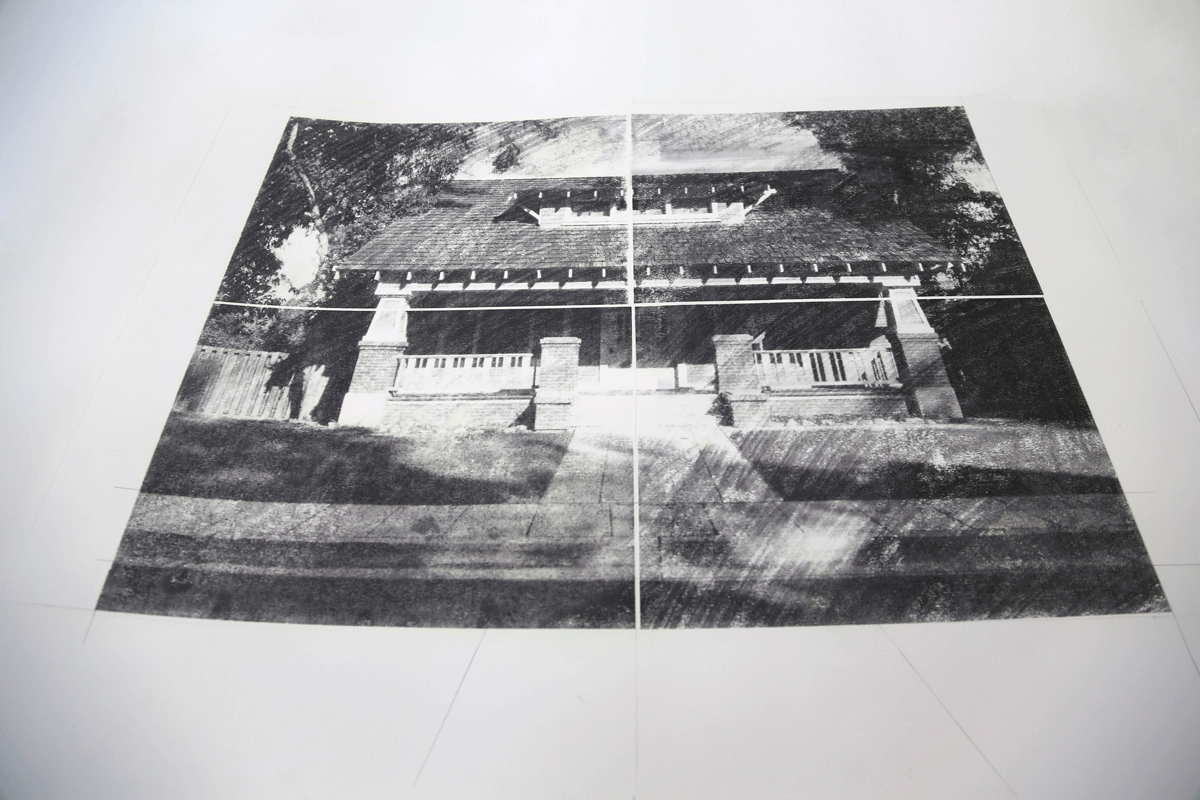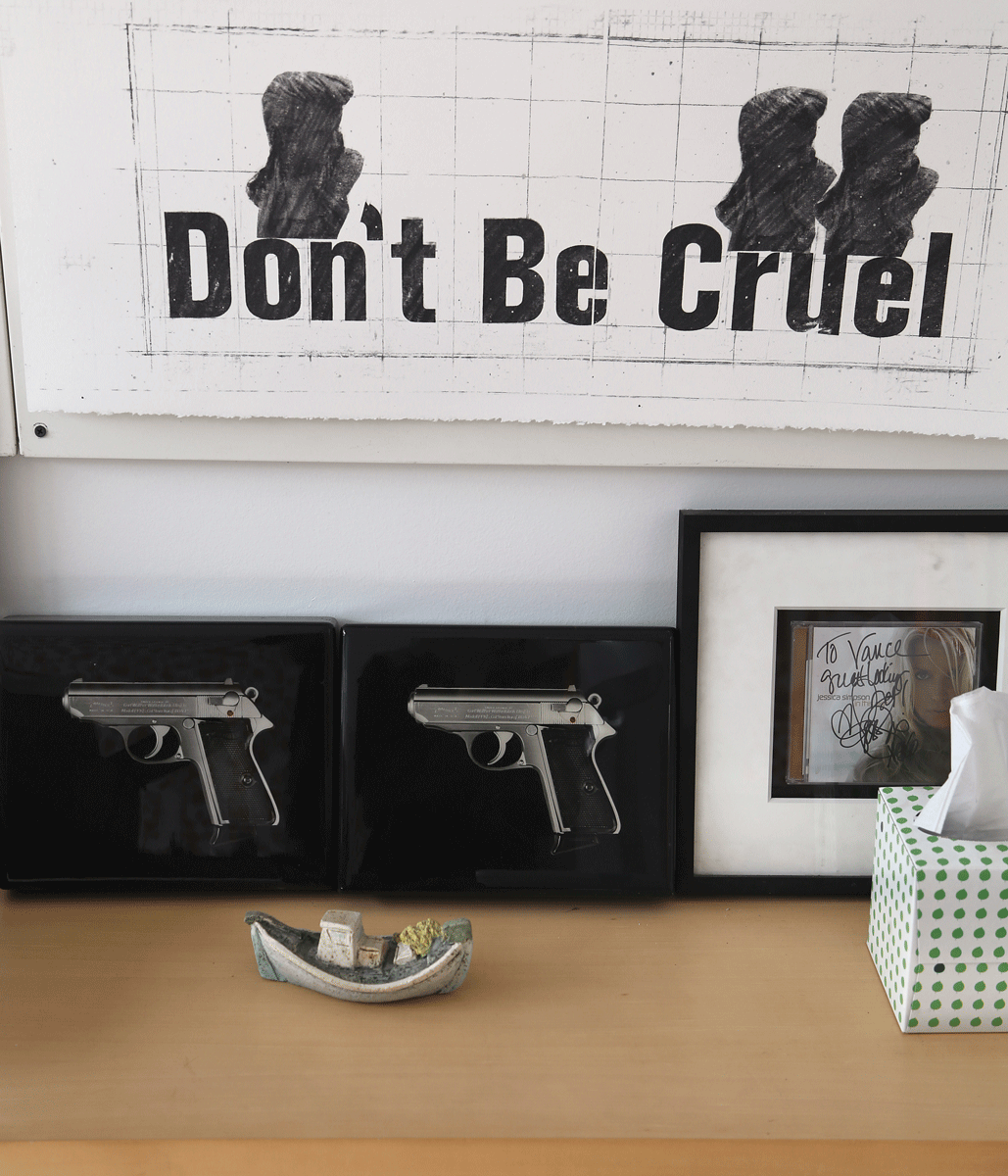

“Hey Man,” Dennis Hopper Series. 48 X 84 Inches. Courtesy The Artist.


Interior Studio, Vance Lorenzini.
[](#)[](#)
Vance Lorenzini
Making Future-Art, Knowing the Past
In his very early 20s, Paul Cézanne \[Editor’s Note: perhaps the greatest bald painter outside of Pollock and Picasso\] received a letter from his friend Émile Zola, saying, “There are two men inside the artist, the poet and the craftsman. One is born a poet. One becomes a craftsman.” Zola made the distinction that creativity was inherent, that the “spark” was there at birth and the poet needs only to train the fingers to become the craftsman.
Vance Lorenzini knows this well. Over the last 30+ years, he’s honed his technique of art direction and production design, working on thousands of music videos, commercials, and films, and often building sets by hand in just a few days. The industrial dystopia in Madonna’s “Express Yourself” video? Lorenzini did that. The trash-heap wasteland of Aerosmith’s “Livin’ on the Edge”? Lorenzini did that too. Even with these accomplishments in tow, the longtime Southern California-resident doesn’t feel fulfilled, yet. He’s making his move into something finer. In person, Lorenzini rarely stops moving his brawny frame. He’s a man who has hands meant for building, who long ago turned his rough palms—tan as any roof worker—to labor, and who could kick your ass without a problem. His art is enormous and imposing; he loves the exertion it requires. Small art, he says, is boring, pointless even. “There is some wonderful art by artists that work small but for me I like the physicality. It gets me tired.”
On this particular day visiting Lorenzini’s studio, the sounds emanating from the old boom box are what seems to be Birth of the Cool-era post-bebop, pushing a creative balance into the room. When his son turns off the music as the interview starts, Vance objects: “Can we keep the music going a little bit? It’s always to keep the swing moving.” Right on.
The first thing to notice in Lorenzini’s studio is the scope and size of his art. Swaths of day-glow cover the left side of the warehouse, screen-printed on four (approximately 12-foot high) canvases. Across them, six casted gunmetal letters spell out the words “HEY MAN” over a cinematic shot of two bikers, a film still from Easy Rider. Lorenzini explains, “I knew Dennis Hopper and I went to his memorial that was down in Santa Monica on the pier. The first speaker who got up and spoke at Dennis Hopper’s memorial was Ed Ruscha. He leaned into the microphone and said ‘Hey man.’ Nobody could say ‘hey man’ as cool as Dennis Hopper.’ So I wrote that down, and I held onto that for over a year. These pieces are homage to him. It’s really homage to the counterculture and what Easy Rider meant, and how we saw things back then and the start of looking at art and creativity a little differently.”
On the opposite side of his expansive studio lies another example of the “HEY MAN” series. These two are unfinished and missing letters but are indented with crosses lined in 24-karat gold. The gold cross, reminiscent of religious Renaissance art, paired with images of 20th\-century pop imagery create curious iconography, illustrating how Lorenzini’s work is informed by both past and future. “I’m interested in how we look at our culture. I’m making these pieces in a way—how we’ll see things 500 years from now, at least my point of view. In the Renaissance, painting and drawing was the medium of the time; film is the medium of our time. We should pay attention to what filmmakers are doing, and what’s being said through film.” In a welcome anomaly from the snobbery that sometimes plagues artists, Lorenzini seems eager, excited even, to speak about the nuances and influences of his art.
“Every day it’s blossomed and grown and one thing has led to another and 500 pieces later…” Even in the presence of the colorful behemoths of his warehouse, his ambition is the largest thing in the room. “And the artists that come before us, I’m reverent to \[them\]. I think Jasper Johns and Warhol and \[Francois\] Boucher are so important to our culture and fine art that I want people to pay attention to that and also pay attention to the work I’m doing. Humbly I say that…This is a pain in the ass to paint these things. Everything I’m doing is a pain in the ass—scale, effort, people. But it’s something I want to say. I’m in.”
